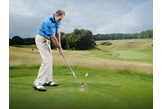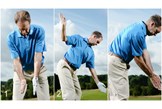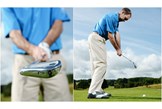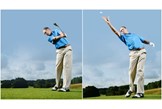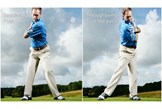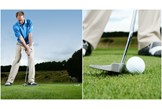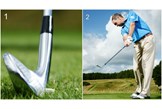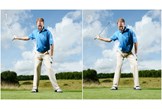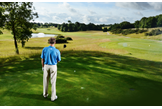Hit your more fairways and greens: An eight-step guide
Published:
You are just eight steps away from hitting more fairways and greens
Hitting fairways and greens is the bedrock of a solid score; you’ll never score well if you’re constantly chipping out of the trees, or trying to get up and down for par.
In this article you will see a phrase – ‘stable clubhead’ – make an regular appearance. That’s because delivering the clubhead with stability at impact is at the core of accurate golf.
In terms of direction it refers to harnessing keeping the blade squarer for longer, increasing your margin for error. For distance control, a stable clubhead relates to the consistent transfer of energy from club to ball. I’ll guide you through eight steps so will work on both, and we’ll round things off with some strategy advice.
➤ Drill #1: Hit shots with split hands
This drill helps you experience a stable shaft and face, and how they contribute to the controlled face rotation that boosts accuracy. Work on it to groove those feelings, before returning to you regular hold and trying it with a full swing

▪︎ Spread your hands
Start this drill by separating your hands on the handle; keep your gloved hand in its regular position and move the trail hand down to the bottom of the grip. Waggle the clubface and feel how, with the hands spread, the face feels less lively and more controlled.
▪︎ Back Face Check
Take your 8-iron, tee up a ball and take your regular stance. Make a half backswing, and stop to check the position of the clubface. By adding stability to the shaft and head, the split- hand grip limits excessive face rotation; the leading edge should match your spine angle.
▪︎ Through Face Square
Now swing through; look to hit the ball only about 80 yards. Again the split-hand hold ghts any tendency to ip or rotate the face, but you can assist the motion by trying to keep the face looking at the target through impact. Hold your finish and inspect the face position (like this).
➤ Drill #2: Clap for accuracy

▪︎ Address: Palms facing
With the focus on rotation in the golf swing, it’s easy to overdo rotation in the hands and forerarms. To feel a more effective move, leave the club to one side. Take your regular set-up but leave your hands an inch or so apart, palms facing.
▪︎ At the top: Palms ‘connected’
Now make a backswing with your trail hand and arm only; leave your lead or gloved hand in its address position. As you swing the arm back, maintain an intention that you will bring the hand back down to ‘clap’ the lead hand.
▪︎ Impact: Smack the glove
Now swing the trail hand back down to clap the gloved hand. Repeat this drill a few times to feel how the trail palm feels “connected” to the lead palm throughout its journey. Finally take a club and look to feel the same trail arm rotation.
➤ Drill #3: Face Twist
To help you keep the face squarer for longer, improve your feel for the face and what it’s doing. You can achieve this by;

▪︎ Turn the club upside down
Take a 7-iron and turning the club through 90 degrees, so the length of the blade looks at the target. Move the club back. The new angle of the head will feel unusual to you, which improves your awareness of it. It also puts the club’s mass along the target line. In this position its face is more reluctant to rotate. This helps calm any tendency to roll the forearms through the first part of your swing.
▪︎ Tap a ball forwards
Give this drill some focus by tapping a ball forwards. Of course don’t worry where the ball goes. But note that to strike the ball in this position the face must avoid rotation through impact – this is another good habit to get into in your quest for accuracy.
➤ Drill #4: Improve your pivot
Your body pivot is what holds the clubface square. Splay your feet to feel how this works;

▪︎ Better Pivot = Straighter Shots
The three steps so far have all focused on the clubface – and when it comes to direction accuracy you have to start here. But during the swing, your rotation back and through makes a big contribution to holding the face square.
▪︎ Wrong Power Source
If you are not powering your swing through the rotation of your body, you will end up trying to create speed with your hands and arms. This inevitably creates excessive forearm rotation, the clubface opening and closing rapidly. Your directional control will suffer.
▪︎ Foot Focus
We tend to see the pivot as an upper-body action, because the shoulders make the biggest turn. But in reality your ability to pivot comes from your feet. They push down, against the ground, to generate the twisting force that delivers the pivot.
▪︎ Creating Your Ground Fource
Note too that when you plant that lead foot, it is relatively splayed, the toe turned out. When you turn your toes out it allows your hips to turn, whilst keeping them stable. This increases the coil effect and helps you to pivot back and through.
▪︎ Feel The Ground-Up Pivot
To feel how this works, place a ball in your trail hand. Throw it forwards and up, as if to mimic the release of the golf club. Note that the power in the throw does not come from the hand and arm; it radiates upwards from your planted lead foot, which supports your rotating core.

‣ Backswing: Push off
To feel how this all relates to a better body pivot, turn the toes of both feet out to create a splayed stance. Hold a club against your shoulders. Push your lead foot instep against the ground to rotate your hips and chest back.
‣ Throughswing: Trail foot push
Now return the favour, pushing off with your trail foot instep to initiate your forward rotation. When you’ve developed a feel for how your pivot is initiated from your feet, return to the golf club and make practice swings, looking to repeat the feeling.
➤ Drill #5: Imagine the club has no loft
Now we move into distance accuracy – and to understand this, we need to look at the golfers who have mastered it; Tour professionals. We’ve often heard in commentary that a player in really on their game when they’re hitting their approach shots “pin high”. It shows they are in control of the direction and distance of their irons.
The Tour pro averages a 4-5° downward blow, an angle that allows them to maintain clubface stability through impact. It’s this stability that delivers consistent energy transfer from club to ball. Picturing no loft is one of three ways you can improve your own attack angle… and distance control.

▪︎ Push the shaft forwards
To grow this feeling of hitting forwards and not up, place a club on the ground, its shaft pointing down your target line. Address the butt end. Now, simply focus on pushing the clubface into the butt to send the clubhead towards your “target”.
▪︎ Shaft Lean Check
As you do this feel how your hands naturally move forwards, ahead of the clubhead, to create that force through the shaft. You’ll create some forward lean in the shaft – a key indicator of applying the correct, slightly downward attack angle.
▪︎ Try the putt chip
The sight of loft on the face – and the fact we know the ball needs to rise – can lead to a scooping impact that creates no compression, no club stability and no distance consistency. To grasp how this might have got into your game, take a putter – ideally an old one! – and chip a few shots with it, perhaps 40 or 50 yards. With no loft and no expectation of height, any scooping action feels inappropriate. Instead, you will simply focus on driving the ball forwards.
➤ Drill #6: Feel a pressure impact

▪︎ Tee peg obstruction
Find a long tee peg and stick it deep into the ground. Leave just the thicker top part above the turf. Take your 7-iron and set up to the tee. Place the leading edge against it.
▪︎ Now burst through!
Keep pushing until the club bursts through the tee peg. Allow yourself to ow into your followthrough. See how, with that correct pressure creation, you are able to extend down the target line after “impact”. Look to recreate this with a ball.
▪︎ Push against the tee
The key to this drill is to apply pressure against the tee through the club. Providing the turf is firm, the peg provides enough resistance for you to build up quite a lot of force. You will quickly feel that to push the club harder against the tee, you need to push off through your back foot.
▪︎ Keep the pressure on
The technique you are using to apply pressure against the tee is exactly the one you need to compress the ball correctly during the full swing. Keep pushing until you can feel the shaft starting to bow, and absorb the sensation of downward, forward pressure.
➤ Drill #7: Blend your transition to create ‘lag’
Lag can be roughly defined as the angle between your clubshaft and wrists. Create this angle and you can release the club downwards, into the ball. Without it, your attack angle will tend to be too shallow. To learn what lag should feel like and how to create it, focus on your change of direction.

▪︎ Three-quarter backswing
Take your 7-iron. Turn it upside down and grip it by the head, with your trail hand only. Make a three-quarter backswing. The angle between your arm and the shaft should be just short of a right angle. Now start forward by feeling your lead knee and weight move to the target.
▪︎ Cock your wrists
As you change direction, allow your wrist to increase its cock while the arm pretty much holds position. Now you have the “head” in a position where it can lag behind, arriving later and with more speed and compression. Work on this with the club inverted. When the motion starts to come more naturally groove the feeling with the club the right way round, though keep it trail-hand only.
➤ Drill #8: Plan your shot better
These seven previous steps will go along way to improving your technique – but that counts for nothing if you don’t have an effective plan for the shot. Focus on these five areas to ensure your strategy matches your swing.

▪︎ Take Your Time
When you’re faced with a tough shot, the huge temptation is to get it over with. But rushing the shot brings disaster. Instead, take your time. Stand directly behind your ball target line and absorb the entire scene, hazards and all. Realise the fairway is wide; you could probably t 1,000 balls across it, and you only need one of those. Above all, prove to yourself that while the shot is tough, a good outcome is a possibility.
▪︎ Lock On To Your Target
Dangerous hazards like water have an ugly habit of grasping your attention. You can’t ignore it, but you can release yourself from its hold by picking your target and committing to it throughout the planning stage. The clearer you define your line, the easier this comes, so pick an intermediate target to help you. Drum this line into your mind’s eye and you’ll be better able to resist that last-second doubt that breeds a ‘safety’ adjustment… and usually disaster.
▪︎ Keep Aware
Some tees have mower stripes that may – or may not – point you down the fairway. It’s important you become aware of these lines and how they relate to your chosen shot path because it’s easy to be subliminally in uenced by them. Similarly with the tee markers; they will not necessarily line up square to your shot. The bottom line is to use these elements to help you aim… and ensure they don’t use you.
▪︎ Mind Your Body Language
Be aware of how you stand, move and breathe. Simply standing tall with good posture can help give you a feeling of confidence. Take this feeling into your practice swing. Hold a balanced finish, looking down the fairway; try to look as composed as possible to any onlooker. Moving like this helps you feel confident and committed, and helps you ward off feelings of twitchiness. A deep breath also helps slow your heart rate and keep you calm.
▪︎ Go With What You Know
Your best chance of pulling the shot off lies with hitting the shot you are most comfortable with. It’s important you don’t let the hazards or the hole force you into using a club – or a shape of shot – that makes you anxious. That can mean playing for a left-to-right shot even if the hole bends the other way, or changing clubs if you think it will help you commit with a con dent swing.

